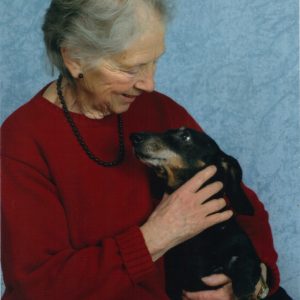In Memoriam: Patricia O’Hanley

Animals always instinctively knew they’d be safe with Patricia O’Hanley. Lost, shy dogs would approach her, sniffing cautiously. Feral cats roamed her yard, and rescued roosters strutted about. Once, when she returned from grocery shopping to her Carnation farm, she found an injured hawk in her driveway, its wing crooked and bent. Pat went inside to drop off her groceries before setting out to help her avian guest. As she unpacked, she took a glance toward the back door: there was the hawk, waiting expectantly on the mat as if asking to be let inside.
It knew, somehow, that it had found refuge and hope of a better life with Pat’s help.
Pat’s legacy has been far-reaching in the animal world. She never met a dog she didn’t love—and who didn’t love her. A lifelong resident of the Pacific Northwest, Pat’s parents instilled in her a love of animals at an early age. Perhaps the magnetism that drew animals to Pat was genetic—it’s said that her father, walking home across the neighborhood, sometimes found himself the ringleader of a pack of friendly local dogs.
Pat’s family found success in the days of Pat’s childhood. As an only child, her hardworking parents played a large role in the woman Pat would become. Her father’s family hailed from Belfast, and her mother was an English immigrant, proud of her heritage. A professional golfer, her father made his own golf clubs and was skilled in craftsmanship. To keep young Pat safe, he fashioned a custom collar with a child-sized handle for the family’s Airedale terrier, Mickey. He placed Pat’s hand on the collar’s handle and said: “Wherever you go, Mickey goes with you.” Thus did a life of animal companionship begin and Pat learned that a dog at her side was the best feeling in the world.
As Pat grew up—graduating high school early and earning her Master of English at 22—she always knew she wanted her legacy to benefit Washington’s animals. Beginning in the 1960s on just a high school teacher’s salary, Pat began investing in real estate throughout Washington. Her intentions for the properties were not secret: she wanted to donate the proceeds from the sales to animal welfare organizations.

“She told everyone,” says close friend Julie Gaisford. “Even the postman knew.” Although property values in the Seattle area skyrocketed, Pat continued her mantra: “I’m not selling. This is for the animals.”
Though she loved all animals, Pat held a special place in her heart for dachshunds and hounds of all breeds. Pat’s favorite dachshund, BJ, revealed an extraordinary talent for show. After entering a local competition for fun, BJ kept winning—and winning and winning, culminating in a trip to the 2009 Westminster Dog Show. Though he didn’t place there, he’d already amassed several regional and national titles and continued to take trips around the country afterwards. (Continuing to demonstrate her natural magnetism for canines, she once had to leave an obedience ring because too many competing dogs were becoming distracted by her presence, wanting to snuggle with her rather than show off their obedience training.) The show circuit allowed Pat, a passionate and driven personality, to develop a strong network of animal advocates, which she called on to help rescue dogs.
In addition to ferrying BJ to shows, teaching high school, and earning a law degree in the evenings, Pat also ran an informal hound rescue network using her contacts from show business and her
natural power of persuasion. Her business card reads “Any hound, any time”—and she meant it.
Though Pat was a notably private person according to her friends Julie Gaisford and Sherry Grindeland, she was always willing to fight publically for what she believed in. She was “small in stature, but big in personality,” enabling her to accomplish things others would only dream of doing. She traveled to Louisville, Kentucky, to help register Black voters during the civil rights movement. Unsurprisingly, she later worked for a civil rights law firm in Seattle. She was one of the first teachers to cover Japanese internment in Washington State, bringing a local resident into her classroom whose family had been impacted by the practice. Later, she would have the opportunity to fight injustice in her literal back yard.
The land that Pat called home spans over one hundred acres and sits next to a popular and far-flung hunting site. For years, she battled hunters chasing pheasants and other wild game onto her property. Undeterred by No Trespassing signs and barbed wire, she found herself the target of ire from hunters pursuing their quarry onto her property.
“She told me at least one of the men pointed a shotgun at her when she confronted him,” Julie says. That’s the kind of person Pat was—unwilling to back down when a challenge presented itself. Her stance against hunting is now written into the law of her land—her property has a no hunting in perpetuity clause attached to it.
Though Pat passed away in late 2017, her lifelong love of animals and insistence on bettering the world even in the face of opposition lives on. Homeward Pet and other animal organizations are some of the beneficiaries of her will.
According to Julie and Sherry, Patricia had two major dreams for the future of animal welfare: “She hoped all animal shelters would become no-kill, and that animal lovers would consider giving to causes they care about.”
It’s safe to say that Pat’s example is inspirational. The dogs and cats in our care will be forever grateful for her generosity and life’s works. Homeward Pet Board President Michael Ziock puts it like this: “With her amazing bequest, Patricia O’Hanley will live on in the stories of every animal saved and every Homeward Pet family made complete. With unending gratitude—thank you, Patricia.”

